Italian pasta is a beloved staple, celebrated worldwide for its versatility and rich flavors. With over 400 shapes, it offers endless culinary possibilities, from simple dishes to elaborate creations.
What is Pasta Exactly?
Pasta is a traditional Italian dish made from dough, typically consisting of wheat flour and water. It is shaped into various forms, such as long noodles, short pieces, or stuffed varieties. Pasta can be fresh or dried, with fresh pasta offering a softer texture and dried pasta providing longer shelf life. This versatile food is boiled or baked and often paired with sauces, making it a cornerstone of Italian cuisine and a global culinary favorite.
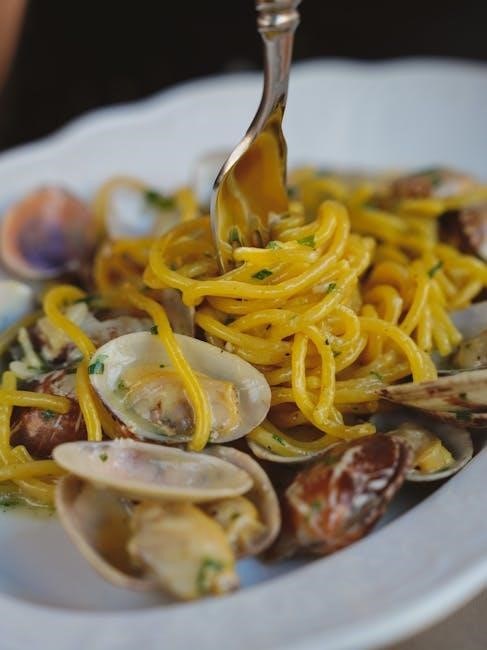
The Origin of Pasta
Pasta likely originated from Asian noodles, introduced to Italy through trade routes. Marco Polo is often credited, though Italy refined and popularized it into a cornerstone of Mediterranean cuisine.
Historical Background and Evolution
Pasta’s origins trace back to ancient times, with noodles introduced to Italy via Asian trade routes. While Marco Polo is often credited, historical records suggest pasta existed in Italy before his travels. Early forms like “lagana” (lasagna) and “fideus” (pasta-like dough) were consumed. By the Middle Ages, pasta became a staple, especially in southern Italy, where durum wheat flour was abundant. Over centuries, pasta evolved, with new shapes and sauces emerging, particularly after the Renaissance, when tomatoes were introduced from the New World.
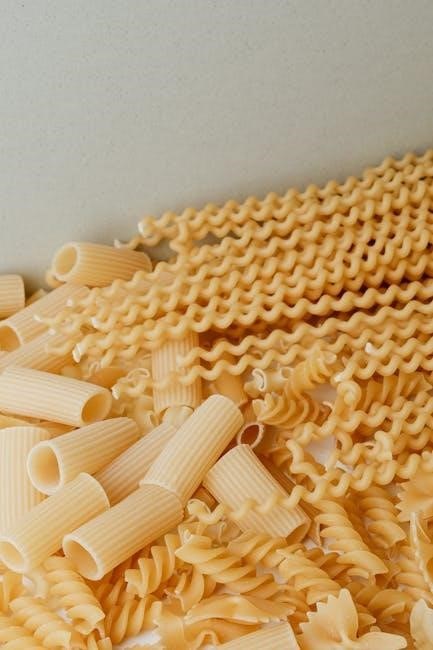
Types of Italian Pasta
Italian pasta offers incredible diversity, with shapes like spaghetti, linguine, penne, farfalle, and rigatoni. Each shape is designed to complement specific sauces, enhancing flavor and texture.
Long Pasta Noodles
Long pasta noodles, such as spaghetti, capellini, and bucatini, are iconic for their slender, elongated shapes. These noodles are ideal for light, oily, or creamy sauces, as they coat evenly without overpowering the pasta. Spaghetti, one of the most recognizable types, is famously paired with tomato-based sauces like Bolognese or Carbonara. Capellini, finer and more delicate, excels with delicate seafood or herb-infused oils. Bucatini, thicker and hollow, is perfect for rich, hearty sauces. These long noodles are versatile and timeless, making them a cornerstone of Italian cuisine.
Short Pasta Noodles
Short pasta noodles, such as rigatoni, penne, and farfalle, are characterized by their compact shapes, making them ideal for hearty, chunky sauces. Rigatoni, with its tube-like structure, pairs perfectly with robust meat ragùs. Penne, featuring angled ends, holds onto creamy sauces and pesto beautifully. Farfalle, or bow-tie pasta, adds a playful touch to light, delicate dressings. These versatile shapes are also excellent for baked pasta dishes and salads, offering a satisfying texture in every bite.
Tubed Pasta Varieties
Tubed pasta varieties, such as penne, rigatoni, and ziti, are designed with hollow centers to trap flavorful sauces. Penne, with its angled ends, is perfect for chunky tomato or creamy sauces. Rigatoni, featuring ridged tubes, holds onto hearty meat ragùs. Ziti, smooth and cylindrical, pairs well with robust tomato-based sauces. These versatile shapes are ideal for baked dishes and casseroles, offering a satisfying texture that complements a wide range of flavors. Their sturdy structure ensures they hold up beautifully to thick, rich sauces.
Stuffed Pasta Varieties
Stuffed pasta varieties, like ravioli and tortellini, are filled with ingredients such as cheese, herbs, or meat, offering a burst of flavor in each bite. Ravioli, typically square or circular, is often filled with ricotta or spinach, while tortellini, ring-shaped, usually contains meat or cheese. Agnolotti, a stuffed pasta from Piedmont, is filled with roasted meat or vegetables. These varieties are often served with light sauces to highlight their rich fillings, making them a delightful and satisfying dish in Italian cuisine.

Regional Pasta Specialties
Italian pasta specialties vary by region, reflecting local ingredients and traditions. From northern hearty dishes to southern fresh, bright flavors, each area boasts unique pasta traditions and ingredients.
Northern Italian Pasta Dishes
Northern Italy boasts rich, hearty pasta dishes, often featuring butter, cream, and cheese. Dishes like Tajarin (thin, hand-cut pasta with butter and truffle) and Risotto alla Milanese (saffron-infused rice with ossobuco) highlight regional flavors. Canederli, dumpling-like pasta from Trentino-Alto Adige, combines bread, milk, and speck, showcasing Alpine influences. These dishes reflect the north’s abundance of dairy and meat, creating bold, comforting meals that embody the region’s culinary heritage and love for rich, satisfying flavors.
Central Italian Pasta Dishes
Central Italy is renowned for its rich, hearty pasta dishes, often featuring fresh ingredients like mushrooms, truffles, and cured meats. Dishes such as Pappardelle al Cinghiale (wild boar ragù) from Tuscany and Spaghetti alla Carbonara from Rome showcase the region’s love for bold flavors. Umbria’s Strangozzi with truffle sauce and Emilia-Romagna’s Tagliatelle alla Bolognese highlight the diversity and richness of central Italian cuisine, blending tradition with local ingredients to create unforgettable meals.
Southern Italian Pasta Dishes
Southern Italian pasta is vibrant and flavorful, often showcasing fresh ingredients like tomatoes, garlic, and olive oil. Dishes such as Spaghetti Aglio e Olio (spaghetti with garlic and oil) and Paccheri alla Napoletana (tubed pasta with tomato sauce) highlight the region’s simplicity and bold flavors. Sicily’s Casarecce con Pesce (fish-based pasta) and Campania’s Fusilli alla Pugliese (with cime di rapa) reflect the Mediterranean diet’s influence. These dishes emphasize fresh, local ingredients and regional specialties, creating a true taste of Southern Italy.
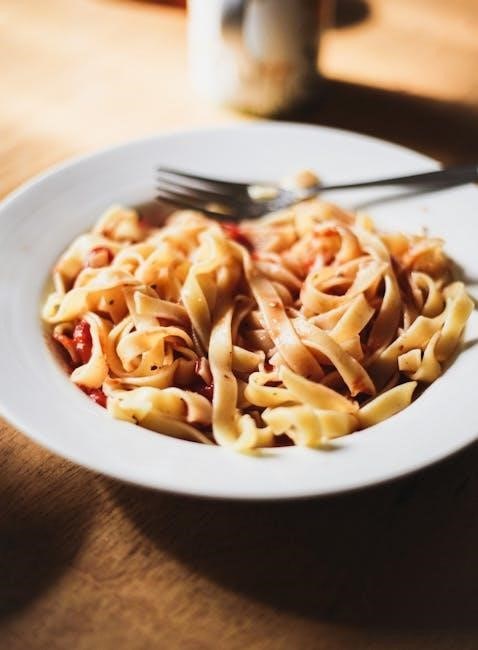
Pairing Pasta with the Right Sauce
Pairing pasta with the right sauce enhances flavors. Tagliatelle pairs perfectly with rich ragù, while orecchiette complements broccoli rabe, and trofie is ideal for Pesto alla Genovese.
Classic Sauce and Pasta Combinations
Classic Italian sauce and pasta combinations are timeless. Spaghetti pairs perfectly with tomato-based sauces or light olive oil, garlic, and chili. Linguine shines with seafood, while trofie is a match for Pesto alla Genovese. Tagliatelle is ideal for hearty ragù, and orecchiette complements earthy broccoli rabe. These pairings highlight how pasta shapes and sauces are designed to work in harmony, creating balanced and flavorful dishes that define Italian cuisine.
Cooking Techniques and Tips
Pasta should always be cooked al dente for the best texture. Minimal cheese is recommended for seafood pasta to avoid overpowering delicate flavors. Proper drying techniques enhance quality.
How to Cook Pasta Al Dente
Cooking pasta al dente is essential for optimal texture. Use salted water and avoid overcooking. Check doneness by biting; it should feel firm in the center. Timing varies by shape, but most pastas need 7-12 minutes. Stir occasionally to prevent sticking. Drain immediately and rinse only if necessary. Serve with sauce to coat evenly. High-quality pasta retains al dente texture best. Proper cooking ensures a satisfying bite and enhances flavor absorption.
Adding Flavor to Homemade Pasta
Elevate your homemade pasta by infusing flavor during production. Use eggs for richness or herbs like basil for freshness. Add garlic, spices, or saffron for unique twists. Incorporate ingredients like spinach or beets for vibrant colors and subtle earthy notes. Mix in grated Parmesan or nutritional yeast for a savory depth. Season the dough generously with salt and consider adding olive oil for moisture. These techniques ensure a more complex and delicious pasta experience from the start.
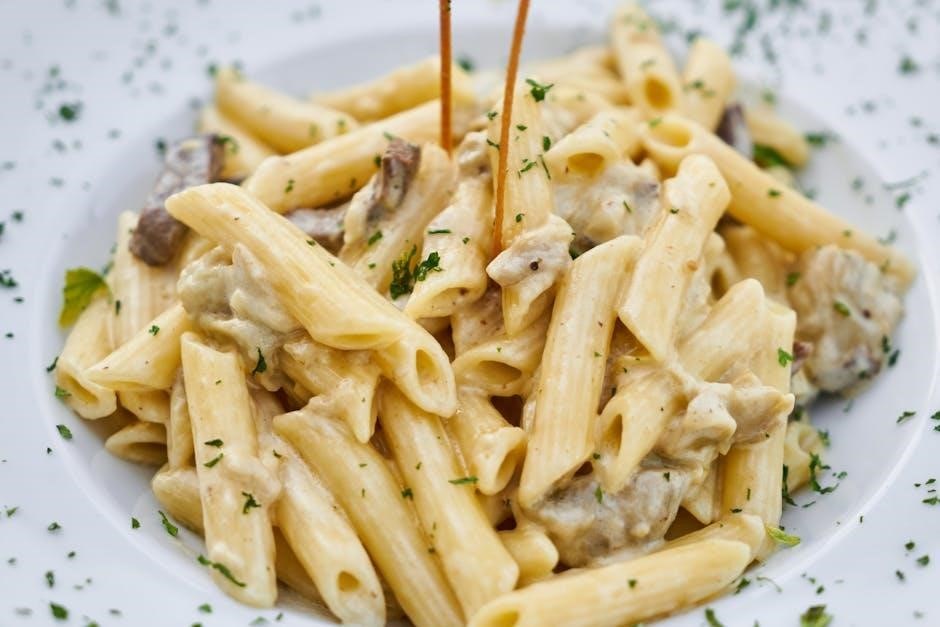
Popular Italian Pasta Dishes
Iconic dishes like Spaghetti Carbonara, Cacio e Pepe, and Pesto alla Genovese showcase Italy’s culinary mastery. These beloved recipes highlight simplicity, fresh ingredients, and rich, authentic Italian flavors.
Spaghetti Carbonara
Spaghetti Carbonara is a timeless Italian classic, originating from Rome. Made with guanciale (cured pork jowl), eggs, Pecorino Romano cheese, and black pepper, it’s a rich, creamy dish without any cream. The eggs create a velvety texture when tossed with hot pasta and cured meat. Traditionally, no mushrooms or heavy cream are used, keeping it authentic and simple. Pair it with a dry white wine for a quintessential Italian dining experience.
- Ingredients: Spaghetti, guanciale, eggs, Pecorino Romano, black pepper.
- Key: No cream, just eggs for creaminess; guanciale adds smoky flavor.
Cacio e Pepe
Cacio e Pepe is a quintessential Roman dish, embodying Italian simplicity. Made with Pecorino Romano cheese and black pepper, it creates a creamy, savory sauce when combined with pasta water. Traditionally, no cream is used, relying on the cheese’s richness. Served with spaghetti or tonnarelli, it highlights the harmony of minimal ingredients. A staple in Roman cuisine, it’s cherished for its bold flavors and straightforward preparation, making it a must-try for pasta enthusiasts.
- Ingredients: Pecorino Romano, black pepper, pasta water.
- Key: Creamy texture from cheese, no added cream.
Pesto alla Genovese
Pesto alla Genovese is a classic Italian sauce originating from Genoa. Made from fresh basil, garlic, pine nuts, Parmesan cheese, and olive oil, it’s a vibrant, flavorful condiment. Traditionally paired with trofie or linguine, it’s a celebration of Liguria’s culinary heritage. The sauce’s bright green color and aromatic freshness make it a summer favorite. Authentic preparation requires a mortar and pestle to blend ingredients, ensuring a smooth yet textured consistency. It’s a testament to Italy’s love for simple, high-quality ingredients.
- Ingredients: Basil, garlic, pine nuts, Parmesan, olive oil.
- Pairing: Trofie, linguine, or other Ligurian pastas.
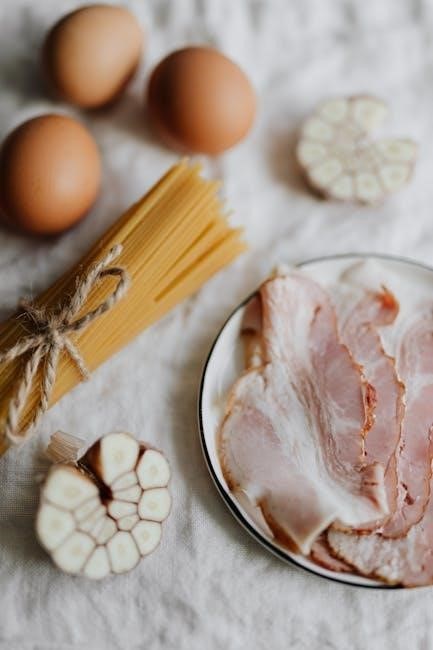
Health Benefits of Pasta
Pasta is a good source of energy, B vitamins, and fiber, especially whole-grain varieties. It supports healthy digestion and provides sustained energy without excessive fat or calories.
Nutritional Value of Pasta
Pasta is a nutrient-rich food, providing carbohydrates, fiber, and essential B vitamins. Whole-grain pasta offers higher fiber and nutrients like iron, magnesium, and selenium. It is low in fat and calories, making it a balanced choice for healthy meals. Enriched varieties often contain folic acid, crucial for cell growth. When paired with vegetables and lean proteins, pasta supports a well-rounded diet. Opting for whole-grain over refined pasta boosts nutritional benefits, aiding digestion and energy levels without excessive calories or fat.
Low-Calorie Pasta Options
For those seeking lighter options, whole-grain or vegetable-based pastas are excellent choices. Zucchini noodles (zoodles) and spaghetti squash offer low-calorie, low-carb alternatives. Whole-grain pasta provides more fiber and nutrients while keeping calories moderate. Pairing these options with light, herb-based sauces instead of creamy or cheese-heavy ones further reduces calorie intake. These choices make pasta dishes more diet-friendly while maintaining flavor and satisfaction, ideal for health-conscious individuals looking to enjoy Italian cuisine guilt-free.
Italian pasta is more than just a meal; it’s a reflection of history, culture, and community. From hearty traditional dishes to innovative modern recipes, pasta brings people together. Embrace the culinary journey, where every dish is a celebration of love, simplicity, and heritage. Whether you’re a pasta aficionado or just beginning to explore, let Italian pasta inspire your table with its endless possibilities and timeless charm.
